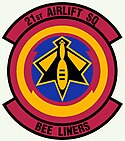21st Troop Carrier Squadron
| 21st Airlift Squadron | |
|---|---|

21st Airlift Squadron C-17A Globemaster III, 06-6154
|
|
| Active | 7 March 1942 – Present |
| Country |
|
| Branch |
|
| Type | Strategic Airlift |
| Part of | 60th Operations Group |
| Garrison/HQ | Travis Air Force Base, California |
| Nickname(s) | BEEliners |
| Engagements |
World War II (Asia-Pacific Theater) Korean War |
| Battle honours |
Distinguished Unit Citation (7x) Presidential Unit Citation Air Force Outstanding Unit Award with Combat "V" Device Meritorious Unit Award Air Force Outstanding Unit Award (15x) Philippine Presidential Unit Citation (World War II) Republic of Korea Presidential Unit Citation Republic of Vietnam Gallantry Cross with Palm |
| Commanders | |
| Notable commanders |
Charles R. Holland |
| Insignia | |
| 21st Airlift Squadron Emblem |  |
| Aircraft flown | |
| Transport | C-17 Globemaster III |
The 21st Airlift Squadron (21 AS) is part of the 60th Air Mobility Wing at Travis Air Force Base, California. It operates C-17 Globemaster III aircraft supporting the United States Air Force global reach mission worldwide.
Provide services and support, which promote quality of life and project global power through combat-proven airlift and airdrop.
The squadrons origins date to the activation of the 21st Air Transport Squadron (ATS) at Archerfield Airport, Brisbane, Australia in the spring of 1942. Activated in the wake of the United States withdrawal from the Philippines, the squadron was formed with a mixture of personnel withdrawn from Clark Field and some reinforcements which had arrived in Australia but did not see combat in the Philippines.
The squadron was hastily put together with some impressed civilian Douglas DC-2s and DC-3s with a mission of transporting personnel, equipment and supplies within Australia, organizing American and Australian forces against the perceived Japanese invasion of Australia. Not having a formal command structure, the 21st ATS was assigned directly to the Fifth Air Force, Army Air Forces in Australia.
Over the next few months the squadron was assigned additional aircraft, flying derivatives of the Lockheed C-56 and C-60 Lodestar along with a war-weary four-engine Boeing B-17D Flying Fortress withdrawn from the Philippines and a Douglas B-18 Bolo which had found its way to the South Pacific. The squadron entered combat on 5 July 1942, being re-designated the 21st Troop Carrier Squadron. It participated in a paratroop drops at Nadzab, New Guinea, in September 1942. It continued to fly combat re-supply and casualty evacuation missions from Brisbane.
...
Wikipedia
